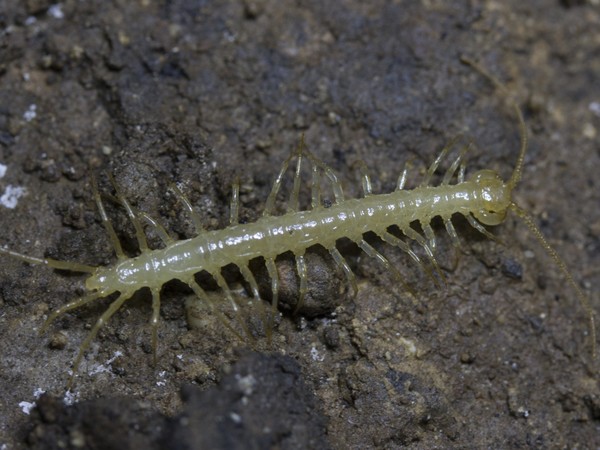Some species of centipedes seem to actively spend a considerable part of their lives not on dry land, but underwater, where they have interesting opportunities for hunting. This has been revealed through surprising observations of speleologists, who found the Lithobius matulici centipede species deep in flooded caves. Experts from the UP Faculty of Science participated in the findings.
The testimonies of cave divers, which may radically change the way zoologists classify centipedes as terrestrial creatures, is a key part of a new study by experts from the Hungarian Natural History Museum, Loránd Eötvös University in Budapest, and the Department of Ecology and Environment at the Palacký University Olomouc Faculty of Science. The results of the study focusing on centipedes were published in the journal ZooKeys.
Centipedes have been living on the Earth for more than 420 million years. Zoologists usually consider them soil organisms, since most of their species inhabit the upper layers of the soil or live under stones and dead wood and in leaf litter. According to previous observations, centipedes prefer to avoid water. There are exceptions to the rule, such as species living in flood areas and able to survive underwater for several days in a state of stupor; however, they flee when a big flood comes. “Only some jungle centipedes are able to swim and hide at the bottom of a creek when disturbed. Also, about 3 percent of soil centipedes (genus Geophilomorpha) live on the rocky seaside in the intertidal zone, where they search for food during low tide and hide in shelters during high tide,” said one of the co-authors of the article, Ivan Hadrián Tuf.
Hungarian speleologists, however, have observed centipedes in the Vjetrenica cave in Bosnia and Herzegovina – which is permanently flooded – and managed to capture and document some of them, to the zoologists’ joy. “One of the divers took a centipede underwater, put it in the cuff of his neoprene suit, and spent another two hours underwater with it. He remembered having it only a long time after having emerged, so he took a picture of it on the ground – and the centipede ran away. Obviously, if he were a zoologist, he would have immediately emerged in awe and ecstasy, and seek other specimens,” laughed Tuf.
Zoologists determined that the centipede found underwater belonged to the Lithobius matulici genus. Approximately at the same time, speleologists in other flooded caves obtained video recordings of the centipedes’ weird behaviour. “Because we got hold of several centipedes from this cave, we decided to accompany their description with a report about their diving. The interesting thing is that they are representatives of an old order of the most common centipedes, which have never been seen to go underwater,” Tuf pointed out.
The circumstances of the discovery suggest that these cave species are able to remain underwater for a very long time. Divers encountered them deep in the cave, and there were no air bubbles in their proximity. The centipedes, according to Tuf, probably discovered how to stay underwater over a long period of time in the same way as millipedes. Some of their species dive in caves and feed on algae growth. Unlike millipedes, centipedes are primarily predators who stalk their prey. Diving in caves may be quite advantageous for these centipedes, because in addition to small terrestrial invertebrates, they can hunt crustaceans in the water.
“Unfortunately, these cave populations of predatory centipedes are substantially lower than the populations of millipedes. We need to catch more specimens to be able to analyse the contents of their stomachs or to breed them in a lab,” noted Tuf, who knows this will not be an easy task. “In a diving suit, these small centipedes are really hard to catch,” he added, with a smile.
Lithobius matulici inhabits caves in Bosnia and Herzegovina. It is completely blind, weakly pigmented, and has markedly elongated antennae and hind legs. In addition to being adapted to living in caves, it can also actively seek food in the flooded parts of the caves.
